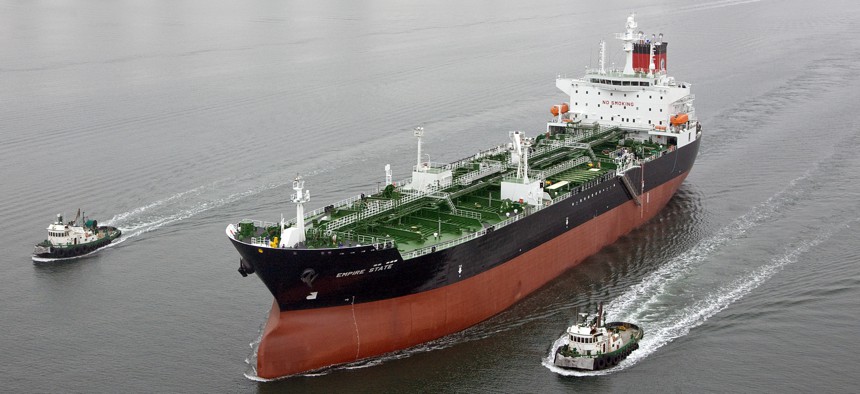
The MT Empire State, one of the tankers employed by the U.S. Navy's Military Sealift Command to haul fuel. Military Sealift Command / Ken Wright
Tanker program adds 9 ships to fuel US military in a crisis
Three companies will each provide three ships.
Nine ships have joined a Defense Department program that puts them on call to haul fuel in a crisis, giving the Pentagon options beyond the handful of commercial tanker ships available now.
The Tanker Security Program was created by the 2021 National Defense Authorization Act, and enables the Department of Transportation to set up a fleet of 10 U.S.-flagged tankers. The U.S. Navy’s Military Sealift Command currently has just five long-term chartered tankers it uses to move fuel.
Though the U.S. military can always hire tankers on the open market, it’s possible that foreign-flagged ships would not be as readily available in a conflict or emergency, said Bryan Clark, a senior fellow at the Hudson Institute.
“The idea is the government wants to have some U.S.-flagged and U.S.-owned tankers that it can turn to and know that, ‘I've got at least these I can hire,’ and then they pay those companies to do that so that those tankers will be on call,” said Clark, who co-wrote a 2020 study by the Center for Strategic and Budgetary Assessments that influenced the creation of the program.
In a worst-case war scenario, the 2020 Mobility Capabilities Requirement Study estimated that the U.S. military would require about 80 tanker ships to meet their needs, Clark said.
“In the logistics world, this is one of the most glaring deficiencies for the U.S. military, is the lack of tankers,” he said. “Because we have lots of aerial refueling, but you know, if you want to get fuel to Guam to then refuel airplanes, it has to travel on a tanker…This has always been sort of [an] Achilles heel of the U.S. logistics infrastructure is the tanker fleet. So, this helps to address that. So that's why it was such a priority for Congress.”
The three companies who have signed up for the program—Overseas Shipholding Group, Inc., Crowley-Stena Marine Solutions, LLC., and Seabulk Tankers, Inc.—will provide three ships each, according to a press release Tuesday by the U.S. Department of Transportation’s Maritime Administration.
Four are already U.S.-flagged ships, while the other five are still working to reflag with help from the U.S. Coast Guard, the release said. A U.S.-flagged ship is one that is registered with the United States and meets U.S. safety requirements, and its operator follows U.S. laws and citizenship requirements, according to the DOT Maritime Administration.
The first tankers in this fleet “will prove essential to our military readiness, particularly in the Indo-Pacific as the Navy transitions away from the Red Hill fuel facility in Hawaii,” Rep. Joe Courtney, D-Conn., said in a statement Wednesday. He currently serves as the ranking member of the House Armed Services’ Seapower and Projection Forces subcommittee.
Each tanker in the program “will receive a maximum $6 million per year payment, prorated on a monthly basis for qualified service as participants in the program,” the Maritime Administration press release said.
Clark expects the Tanker Security Program to grow, but the future size is still unclear. The fleet may not ever meet the full tanker requirement, but they could get halfway there and rely on allied tankers for the rest, he said.




